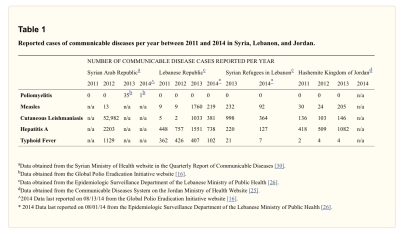 On October 29, 2013. The WHO reported the first polio case in Syria since 1999. 36 polio cases were reported inside the areas out of the government control in Syria, 26 of those cases were in Der el Zor (eastern Syria). Vaccination rate in Syria dropped from 99% to 52% in 2012, leaving many kids under certain age with no immunization. The WHO report in 2014 estimated around 500,000 children under the age of five in Syria with no vaccination. According to UNICEF, despite vaccinating around 1.6 million children until the end of 2015, many were left un-vaccinated especially in the areas north of the Euphrates.
On October 29, 2013. The WHO reported the first polio case in Syria since 1999. 36 polio cases were reported inside the areas out of the government control in Syria, 26 of those cases were in Der el Zor (eastern Syria). Vaccination rate in Syria dropped from 99% to 52% in 2012, leaving many kids under certain age with no immunization. The WHO report in 2014 estimated around 500,000 children under the age of five in Syria with no vaccination. According to UNICEF, despite vaccinating around 1.6 million children until the end of 2015, many were left un-vaccinated especially in the areas north of the Euphrates.
It is estimated that 60% of the hospitals in Syria have been affected. Many of the healthcare providers have been killed, injured, or left the country. In 2015, it was reported that there are only 40 doctors for every 2.5 million people comparing to 2000 before 2011.
On top of the major shortage in healthcare providers, around 700 medical workers have been killed since the conflict started in 2011. More than 300 facilities were hit by missiles or bombs.
The first Geneva convention in 1864 sat a principle to protect healthcare workers and medical space from violence and armed attacks. In 1949, 196 countries including Syria agreed on the update of this principle during the four Geneva convention. Since 1990, multiple violations to this principle have been reported around the world and most recently in Syria where multiple organization are risking human lives to deliver the Polio vaccine to children under the age of five.

Syrian American Medical Society (SAMS) has established multiple medical sites in the areas out of the Syrian regime control to provide medical care to both armed and non-armed population. They also have medical providers localized in Turkey that cross the Syrian border to offer medical help funded mainly by Syrian physicians in the US. They also established collaboration with multiple humanitarian organizations both international and local.
